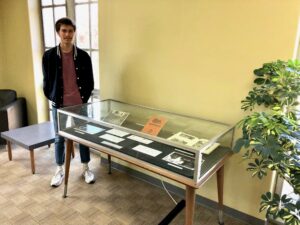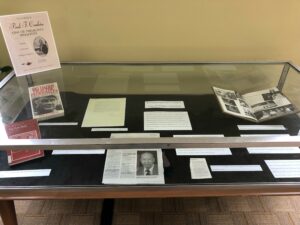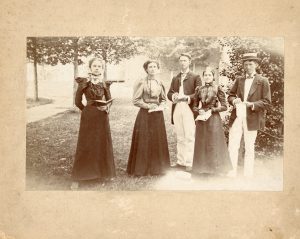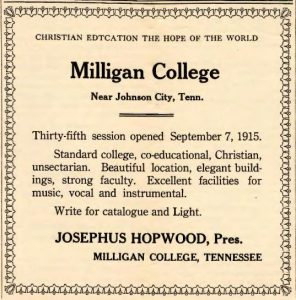After a long hiatus, the Holloway Archives at Milligan University has an intern again. Aaron Jones, a junior history and humanities major, is interning with Katherine Banks, the University Archivist, this spring, learning how archives work and what archivists do. As part of that process, Jones has curated two exhibits from Milligan’s history currently on display on the first floor of the Welshimer Library.
Milligan vs. ETSU: The History of “State Week” delves into the rivalry between Milligan University and the local state university, East Tennessee State University. “Representing the rivalry between ETSU and Milligan was a personal matter for me,” says Jones. “For one, being from around here, I have grown up seeing ETSU sporting events and pride for most of my life. Plenty of people I graduated from high school with now attend the school. Additionally, my younger brother, Hunter, is a sophomore at ETSU. Of course, there is a fun bantering between the two of us about ETSU and Milligan to this day (as I am sure there will always be).” The exhibit explores this decades-old rivalry through the lens of Milligan’s short-lived football program that lasted from 1920 to 1950.
Jones says, “It is interesting to put historical context into silly arguments my brother and I have over the dinner table. Additionally, it was interesting to take a dive into athletics at Milligan from over 70 years ago. As a current student athlete at Milligan, it is cool to get a glimpse into the lives of those similar to me from many decades before.” Jones is a nationally-recognized runner in Milligan’s cross country and track program.
The second exhibit focuses on a completely different topic, Paul Conkin, a Milligan alum. Remembering Paul F. Conkin: One of Milligan’s Brightest explores this Milligan grad’s time at Milligan and his contributions to the field of history. Jones explains why he chose this very different subject for his other exhibit: “I learned of Conkin from my history professor, Tim Dillon. Once I was tasked with creating an exhibit, he seemed like the obvious choice. I was amazed to find out the resume and legacy of Paul Conkin. It makes me proud to be part of the rich history of liberal arts and humanities at Milligan, especially history.” While many Milligan students and alums may have never heard of Conkin, they can now learn about his life and legacy through Jones’s exhibit. Conkin passed away last year, making this an appropriate time to reflect on his legacy. “By sifting through the archives, I felt as if I was following a path backwards in time. I saw it as a mystery to unravel; a personal mission of sorts to bring Paul Conkin to light,” Jones says.
Jones sums up his experience interning in the archives so far quite well: “Digging through the archives and records from the late 1940s to early 1950s has given me perspective on certain aspects of being a student at Milligan. Buildings, street names, and fixtures now have more historical perspective for me.” If you or a student you know would be interested in volunteering or interning in the archives at Milligan, feel free to reach out to Katherine Banks, the University Archivist, for more information.




